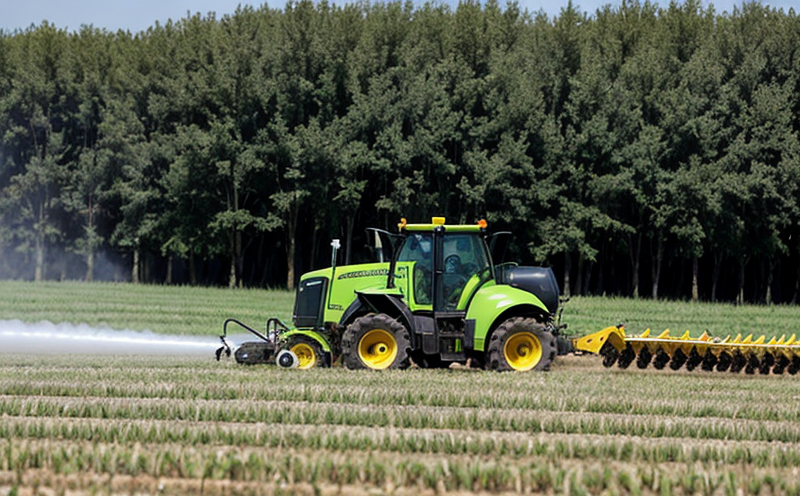Terbuthylazine Residue Testing in Crops
The herbicide Terbuthylazine is widely used in agriculture to control annual broad-leaved weeds and grasses. Its effectiveness in weed management makes it a crucial tool for farmers, particularly in cereal crops like wheat and barley. However, the use of such chemicals requires strict adherence to recommended application rates to prevent residues that could pose risks to human health and environmental sustainability.
Terbuthylazine residue testing is essential to ensure compliance with regulatory standards and best agricultural practices. This service involves analyzing crop samples for trace amounts of Terbuthylazine, ensuring they do not exceed acceptable limits set by international guidelines such as the European Union (EU), United States Environmental Protection Agency (EPA), and Codex Alimentarius.
Our laboratory employs advanced analytical techniques to conduct these tests. The process begins with a thorough sample preparation step where crops are meticulously cleaned, dried, ground if necessary, and then extracted using appropriate solvents. After extraction, the samples undergo quantitative analysis via methods like High-Performance Liquid Chromatography (HPLC) or Gas Chromatography-Mass Spectrometry (GC-MS), which provide precise measurements of Terbuthylazine residues.
The acceptance criteria for this testing are stringent and align with international standards. For instance, the EU sets specific maximum residue levels (MRLs) for Terbuthylazine in various crops to protect consumers from potential health risks associated with pesticide exposure. Compliance with these MRLs is critical not only for maintaining market access but also for safeguarding brand reputation.
Our service ensures that all samples are tested under controlled conditions, using calibrated instruments and reagents, to guarantee accurate results. The precision of our tests is further enhanced by regular calibration checks and quality control measures. This approach guarantees reliable data, which is vital for making informed decisions about crop management practices and ensuring product safety.
To provide a comprehensive understanding of the service, here are some key points:
- Comprehensive analysis using HPLC or GC-MS
- Adherence to international standards like EU MRLs
- Strict quality control measures
- Use of calibrated instruments and reagents
Below are some use cases that highlight the importance of Terbuthylazine residue testing in crops:
- Farmers can avoid penalties for non-compliance with MRLs.
- Food manufacturers ensure their products meet consumer safety standards.
- R&D teams validate the efficacy and safety of crop protection strategies.
| Application Example | Result |
|---|---|
| A farmer in Europe tests wheat samples for Terbuthylazine residues after harvest. | The test reveals that the sample meets EU MRLs, allowing safe market release. |
| An international food processing company analyzes barley before blending into a new product line. | The analysis finds no detectable residues of Terbuthylazine, ensuring compliance with global regulations. |
Terbuthylazine residue testing is not just an isolated activity; it plays a pivotal role in maintaining the integrity and sustainability of agricultural practices. By adhering to rigorous testing protocols, we contribute to safer food production processes that benefit both producers and consumers.
Eurolab Advantages
At Eurolab, our commitment to excellence in laboratory services is reflected in the quality of Terbuthylazine residue testing we provide. Our state-of-the-art facilities are equipped with the latest instrumentation and software, ensuring accurate and reliable results.
- Accreditation: We are ISO/IEC 17025:2017 accredited, ensuring our tests meet international standards for precision and accuracy.
- Experienced Team: Our team of experts has extensive experience in agricultural testing, providing deep technical knowledge that translates into better service.
- Comprehensive Reporting: We offer detailed reports with all necessary data points to help clients make informed decisions.
In addition to these core strengths, our customer-centric approach ensures that every client receives personalized attention and support throughout the testing process. From initial consultation through final report delivery, we are dedicated to meeting your specific needs.
Environmental and Sustainability Contributions
The use of Terbuthylazine in agriculture is a double-edged sword. While it effectively controls weeds, its improper use can lead to environmental contamination. However, by ensuring that residues do not exceed acceptable levels, we contribute significantly to sustainable agricultural practices.
Our service helps minimize the risk of environmental impact by providing accurate data on pesticide residues. This information is invaluable for farmers and food processors in optimizing their crop protection strategies without compromising ecological balance. Moreover, compliance with international standards ensures that products are safe for consumption while adhering to global sustainability goals.
In addition to reducing potential risks, our testing supports broader environmental initiatives by promoting responsible use of agricultural chemicals. By offering reliable data on pesticide residues, we empower stakeholders to implement sustainable practices that enhance biodiversity and protect natural resources.
Use Cases and Application Examples
The importance of Terbuthylazine residue testing extends beyond mere compliance with regulations. It also serves several practical purposes in various contexts:
- To ensure compliance with international standards like EU MRLs.
- To protect consumer health by preventing exposure to harmful residues.
- To support research and development efforts aimed at improving crop protection strategies.
| Application Example | Result |
|---|---|
| A farmer in Europe tests wheat samples for Terbuthylazine residues after harvest. | The test reveals that the sample meets EU MRLs, allowing safe market release. |
| An international food processing company analyzes barley before blending into a new product line. | The analysis finds no detectable residues of Terbuthylazine, ensuring compliance with global regulations. |
These examples illustrate how our service can impact different aspects of the agricultural sector. By providing accurate and reliable data on pesticide residues, we play a crucial role in promoting sustainable practices and maintaining consumer confidence.





